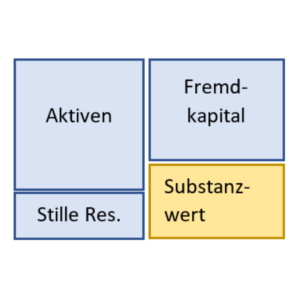Company valuation | How to value correctly? - MKY Group

A company can be valued in various ways. However, there is a distinction between two fundamental perspectives. Either you focus on the substance, or you use the company's earnings.
1. Substantial value
The substance of a company consists of all adjusted assets and its hidden reserves. Both borrowed capital and deferred taxes that accrue on hidden reserves are deducted from this. With this very rudimentary method, you have to note that it is in fact only a snapshot. Ergo: Whether a company is profitable or not is not assessed.

The substance method is a snapshot based on the cut-off date!
The method only focuses on a company's assets, meaning that no attention is paid to the most important success factor — profitability. If you put yourself in the shoes of a buyer, you quickly realize that when taking over a company, the substance of the company is worth knowing, but in many cases is not sufficient for a fair assessment. Information that is ignored here is: profitability, market positioning, current business performance, development potential and market activity.
Nevertheless, the net asset value is justified. Especially in the case of substantive companies, the net asset value can provide a first reference point for goodwill. In addition, the asset value method is part of the practitioner method, which is widely used in the Swiss SME transaction world.
2. Profitability
An income variable such as net profit, EBIT or cash flow is always used as a starting point.
Simply explained:
The company is seen as an investment. As is well known, when investing, people always look at the return and the associated risks. This is known as the so-called return expectation. Now you take the future profits of this company and calculate the value of the company based on the expected return:

An example:
A company makes a net profit of CHF 200,000 and the expected return is 10%. The company value using this calculation method would then be CHF 2 million.
In contrast to the previous substance analysis, the assets of a company play a subordinate role in the income analysis. Rather, the interest lies in the expected profit. In other words: What kind of return can be generated with this company?
Conclusion:
The net asset value method is certainly a good first anchor point in a company valuation (net asset value as a reference value).
However, in SME succession transactions, the focus is definitely on the profitability of a company (profitability as a decisive factor).
For most buyers or successors, an asset is only lucrative when it generates profit. In any case, it is recommended that companies be evaluated using various methods. Methods that also make sense in the context of an SME.
Disclaimer: The content of this blog post is for informational purposes only and does not constitute professional advice. Each individual case should be reviewed individually and we recommend that you seek professional advice for specific questions.




